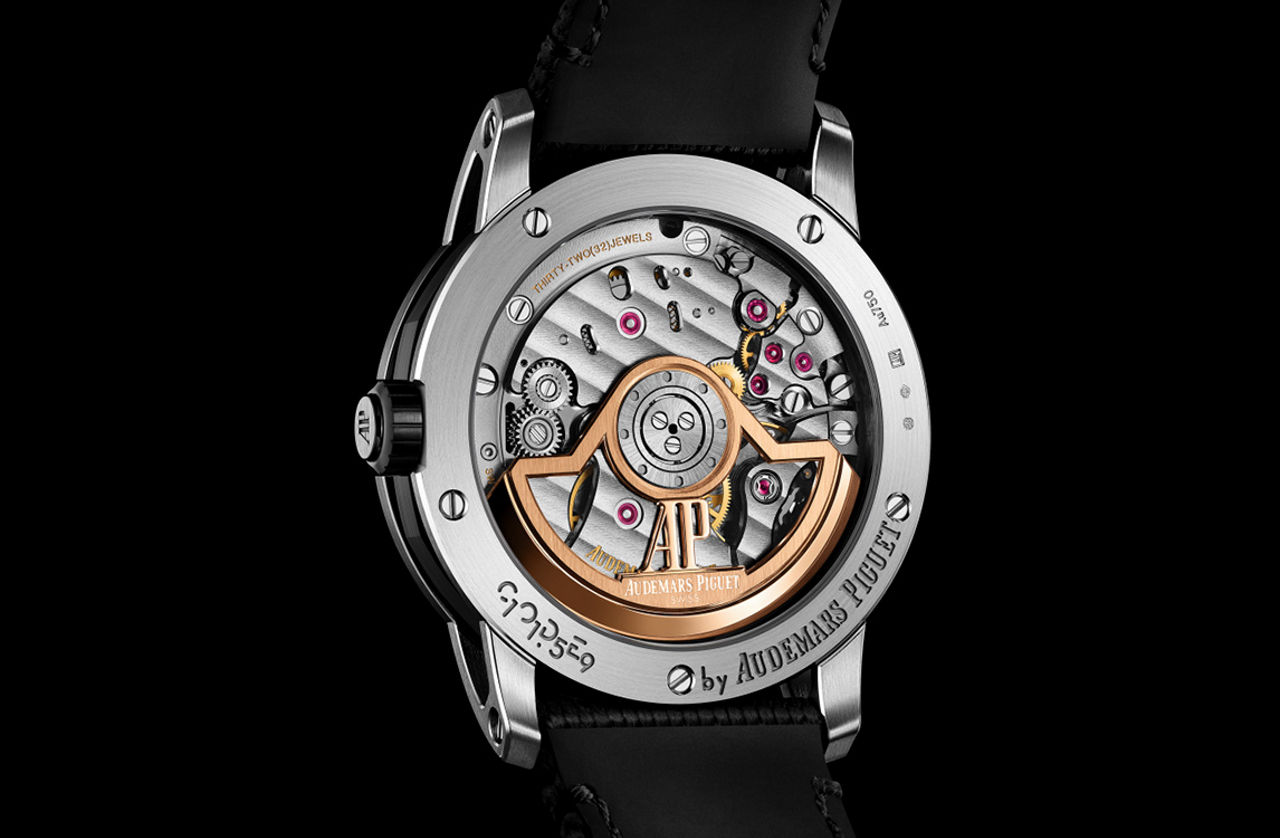The time display is achieved thanks to a central rotor operating a complete revolution in three hours and on which are fixed three aluminium discs that turn on their own axes. Each disc has four digits from 1 to 12 that take turns in pointing to the arched sector at the top of the dial on which the minute scale is printed. The 18-carat white gold trotteuse is slightly curved at the tip to follow the relief of the discs, indicating the seconds like in a traditional timepiece. Blue aventurine serves as a shimmering backdrop for the rotating discs, like planets in the tiny universe of the dial.
STARWHEEL AND THE WANDERING HOURS
The Code 11.59 by Audemars Piguet Starwheel revisits the tradition of wandering hours with a new ultra-contemporary timepiece that combines black ceramic with 18-carat white gold.
On this occasion, Audemars Piguet collaborated with the French artist Ugo Gattoni who developed an original, colourful and imaginative universe to echo the contemporary design of this timepiece and the mysterious technicality of the wandering time display.
AN ULTRA-CONTEMPORARY TRIBUTE TO THE PAST
Invented in the 17th century, wandering hours are a type of horological complication that display the hours using a system of satellites that gravitate along a minute scale arranged in the form of an arc. This aesthetic presentation of the hours and minutes brings a certain mystique to the reading of time.
After falling from favour in the 20th century, this system was rediscovered and reintroduced by Audemars Piguet in 1991. Named the Starwheel, this unusual mechanism equipped many models up until the early 2000s.

Today, the Starwheel is making a comeback in the Code 11.59 by Audemars Piguet collection, whose ultra-contemporary design highlights this fascinating display while also paying tribute to a relatively unknown classic in Haute Horlogerie complications.
The Starwheel universe reinvented by Ugo Gattoni
To accompany the launch of the Code 11.59 by Audemars Piguet Starwheel, an original universe has been developed by the French artist Ugo Gattoni. In addition to his talent as an illustrator, he shares many values with Audemars Piguet, such as a free spirit and a passion for detail.
The result is a poetic and playful world in which the Masters of Time - 3 characters which move on rotating discs - advance in the middle of an intergalactic space in which the Starwheel components gravitate. Together, they assemble the watch by synchronising their movements.


UNCOMPROMISING CRAFTSMANSHIP



A ROTATING TIME DISPLAY

PLAYING WITH MATERIALS
This new 41 mm reference plays with materials by combining an aventurine dial with a case interweaving 18-carat white gold and black ceramic. This diversity of materials as well as the refined hand finishing embellishing the different components create an infinite play of light which underscores the complex design of the Code 11.59 by Audemars Piguet collection.
On the dial side, the double-curved sapphire crystal magnifies both the numerous details present in the blue aventurine and the finishing of the various elements, while also bringing increased depth to the dial.
A STARWHEEL MOVEMENT
For the very first time, the emblematic Starwheel display is integrated into the Code 11.59 by Audemars Piguet collection with the selfwinding Calibre 4310. Combining watchmaking technology, traditional know-how and refined decorations, this next-generation hour, minute and seconds movement is directly derived from the Calibre 4309, to which a new module has been added.

Invented in 1655 thanks to a request by Pope Alexander VII, who suffered from insomnia that was exacerbated by the ticking of his clock, the wandering hours complication was rediscovered by Audemars Piguet in 1991 and combines history, technical challenges, design and poetry.
Sébastian Vivas
Heritage and Museum Director at Audemars Piguet






?size=1071,515&fmt=avif-alpha&dpr=off)




















